Emerging technologies offer new pathways for sustainable efficiency to address Sweden’s public sector grapples with rising service demands, budget constraints, and climate targets. Electric drone is one such technology which shows strong real-world potential for last-mile logistics. A comprehensive systems analysis published in Scientific Reports (Raghunatha et al., 2023) provides shows that electric drones could improve the cost-efficiency, delivery speed, and environmental performance in some cases, particularly in rural and decentralised areas.
Life-cycle cost savings
Delivery logistics today are typically carried out using diesel light trucks or vans. These conventional modes, however, come with high labour and operational costs. When comparing the lifecycle cost (LCC) of drones with diesel and electric vans across four typical delivery routes, it was seen that electric drones emerged as the most cost-effective option in every scenario, with LCC per delivery over 130% lower than for diesel vans and more than 117% lower than for e-vans. Although investments costs for drones are the highest compared to the road vehicles, the primary reason for lower costs through their life cycle is their high degree of automation, labour costs accounting for most of the cost in van-based public logistics (70–76% of LCC). Moreover, sensitivity analysis in the study showed that even for limited drone utilisation, drones remained more cost-effective than vans. When operated 24/7, as is feasible with autonomous systems, the cost per delivery drops even further.
Speed and responsiveness
For blue light services, whether delivering vaccines, test kits, critical infrastructure components, or time-sensitive documents, response speed is critical. Electric drones are seen to be consistently faster than vans by at least 128%, across all delivery scenarios, from rural intercity routes to deliveries in city limits. This speed advantage stems from drones’ ability to bypass road networks entirely, flying direct routes and avoiding congestion or infrastructure bottlenecks. In practical terms, this could allow a municipality to cut the time needed to dispatch urgent medical equipment from hours to minutes. Similarly, local governments could offer more reliable service to citizens in remote or hard-to-reach locations.
Sustainability potential
Sweden’s climate policy includes an ambitious goal of reducing transport-related greenhouse gas emissions by 70% by 2030. Public procurement is expected to play a significant role in achieving this target. While electric vans outperform drones in overall emissions (by 75–92%, depending on route), drones outperformed diesel vans in rural scenarios by emitting 36% and 8% less GHG in the long and short intercity routes respectively. However, drones have higher emissions in rural areas by 6% and 59% in long and short urban deliveries respectively. It is important to note that the drone used for the purpose of this study was capable of carrying 500 kg. Smaller, more energy-efficient drones are needed to improve the environmental case.
Importantly, drone emissions are overly sensitive to both energy source and route design. The study found that using Sweden’s low-carbon electricity mix greatly reduces drone emissions by up to a factor of twelve when compared with the European average. Additionally, drone energy consumption improves significantly over longer routes with fewer stops, making them ideal for rural applications.
More research is needed regarding use of smaller drones, and combinations with trucks, to address payloads, ranges, charging, and the practical operational side. As it is now, drones can be seen as a tool in developing electrified and accessible multimodal logistics system. They are especially well-suited for time-sensitive deliveries and low-density areas. This opens new possibilities such as blue light services or last-mile logistics in remote areas. However, regulatory and practical challenges remain, and partnerships with innovation hubs, academia, and public bodies can help bridge the gap between promising science and implementable solutions.


This article is written by Aishwarya Raghunatha, an Industrial PhD student and expert in drone transport planning and sustainability.
Aishwarya (Aisha) is an industrial PhD student in Advanced Air Mobility and is therefore one of Aero EDIH’s resources. Aishwarya Raghunatha is affiliated with the Future-Proof Cities research program at the University of Gävle.
Her research focuses on Advanced Air Mobility (AAM), exploring how electric-powered or hydrogen-powered delivery drones can contribute to sustainable and environmentally friendly transport systems in urban and rural areas. Specifically, her project examines how sustainability aspects, from the perspective of community inhabitants, energy efficiency, and environmental goals are affected by digital and technological solutions aimed at enhancing resilience in critical infrastructures.
This particular article is based on the study: Raghunatha, A., Lindkvist, E., Thollander, P., Hansson, E., & Jonsson, G. (2023). Critical assessment of emissions, costs, and time for last-mile goods delivery by drones versus trucks. Scientific Reports, 13, 11814.















